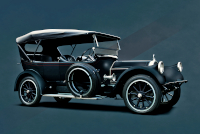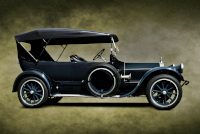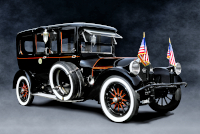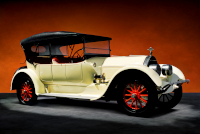Location:
Radnor Hunt Concours d'Elegance, 2007
Owner: Anthony N. D'Alonzo | Havertown, Pennsylvania
Prologue:
Of all the cars on the field for Radnor Hunt's Pierce-Arrow tribute, this Model 31 did not excite me. Sprayed in a hard military green with black running gear, the Model 31 looked big and bland despite its claim to fame. I never intended to use these photos or complete a profile. But after I looked up still images of this car in the 1950 film, "Cheaper by the Dozen," I found an opportunity to illustrate what once was, rather than what is. These images depict chassis #312064 in its 1950 livery as best as I can approximate. The finish is difficult to match, and the color uncertain, a deep cerulean that appears one part cloud blue reflection and one part gunmetal. So as I like to find opportunities to draw lost variations, this one provides a challenge. Whether anyone believes the effort worthwhile, it took about three days to match the finish, though I moved more quickly on the second image. Better for me, however, because I'm happy to add to the portfolio this car and all the stories that come with it.
- - - - - - - - - -
► Image Source: Nikon D200 (10.2 MP)
References:
- Ralston, Marc. "Pierce-Arrow" A.S. Barnes & Co., Inc., San Diego, CA. 1980, page 116, 231
- Automobile Quarterly, Volume 28, Number 4, Fourth Quarter 1990, "The Big Pierces" by Bernie Weis, The Kutztown Publishing Company, Inc., Kutztown, PA, page 51-52, 107
- Bonhams: The Greenwich auction in 2013 saw chassis #312064. Bonhams provides this description and gallery.
- The Gilbreths: Historian James Gifford researched the Gilbreth family and compiled a family biography along with wikis and other resources that chronicle Gilbreth professional accomplishments.
The 4-valve-per-cylinder motor arrived with the Model 31 and 51 replacements for the Model 38, Model 48, and Model 66. (We muddle through the etymological quagmire in the production description.) The core of the matter is that Pierce-Arrow developed their dual-valve six—which actually uses dual intake and dual exhaust valves—out of efficiency and performance. Multiple valves can more reliably do more work than increasingly bigger valves. Both the Model 31 and 51 produced power and torque in the top percentiles of period automobiles, which, running through a four-speed gearbox, made both exceptional performers.
More than speed alone, David Fergusson's engineering and Pierce-Arrow's obsessive quality control produced the most reliable car available, which is not so much speculation as a point proven through trial and backed by the astounding labor processes of the factory. Indeed, Pierce-Arrow's self-professed family culture is a whimsical connection to the Gilbreths, a means of conducting rigorous study to maximize the product all within the context of a family.
Cheaper by the Dozen: The Gilbreth Family in Book and Film
In 1948, two siblings published their collected childhood anecdotes—two siblings of the eleven-ish children of Frank Bunker Gilbreth and Lillian Moller Gilbreth. A feature film of the same name appeared in 1950, and a sequel, Belles on Their Toes, in 1952. A big family, yes, but the parents were scientific motion engineers. In the midst of industrial expansion, Frank and Lillian studied worker actions, which helped produce standard operating procedures for manufacturing. Motion study coincided with the time study work of Frederick Winslow Taylor. Both fields fell under scrutiny by unions, particularly time study, contending that time study sought to pressure workers with scientific evidence for faster performance. The Gilbreths fought to sustain the validity of motion study, and Lillian in particular championed the field for decades after her husband's death.
Lillian Gilbreth became a working single mother of great notoriety, no less as a psychologist and industrial engineer, and no less with (no fewer than) eleven children. Her ascension began with Frank's death in 1924, representing a pre-War trend of women stepping into advanced roles and excelling. Despite endemic sexism among engineers, Gilbreth led research, published, lectured, taught, traveled, and found industrial design consultation work with major American corporations, most notably Johnson & Johnson. And for her success I am wont to suggest that Gilbreth represents a category of pre-War feminism that society became much more skilled at suppressing after the War.
As for the book, multiple editions include a blue Pierce-Arrow on the cover, easily identifiable by its integrated headlamps. In turn, the 1950 and '52 films use a blue Pierce-Arrow, this exact Model 31 Seven-Passenger Touring, chassis #312064. In our depictions, I've tried to re-create the color and patina of the car as painted in the films, (whereas the car wore murky military green paint when photographed). As a people-hauler, the Pierce-Arrow is proper. And of course Frank Gilbreth Sr. did own a Pierce-Arrow, which he dubbed, "Foolish Carriage."
Gilbreth historian James Gifford states that “Foolish Carriage was a 1918 Pierce-Arrow 48-B-5, with a very sophisticated 4-valve engine and a top speed of over 75 miles per hour," which is more consistent with the Model 51, a car sometimes referred to as a fifth series Model 48. (Also, the single production series of the Model 31 and 51 spanned 1918-1919.) Gifford also confirms that the car's nickname is an obvious reference to its cost. But other than a Pierce-Arrow, what car could reliably carry two parents and (within their collective window of co-existence) nine kids? In any case, our Model 31 here is the actual 1919 movie car of the fake Gilbreth family, not the actual 1918 car of the actual Gilbreth family.
Later Cheaper by the Dozen films emerged in 2003 and 2005 with Steve Martin and Bonnie Hunt. So too a Disney+ version in 2022. The name lives on, but these more contemporary stories are co-opted versions without tethers to the original. My journalistic curiosity peters out when it comes to explaining why this point matters, other than noting how much good stuff has been lost in 21st century translation.
Motor: 6,796 cc (marketed as 415 cubic inches, actual 414.7) Series 5 Dual-Valve inline 6-cylinder | 101.6 mm x 139.7 mm (4" x 5½")
The motor is cast iron, cast in pairs of three cylinders. The head is detachable.
Valvetrain: T-head, 4 valves per cylinder, twin-plug ignition via Delco dual distributor
Pierce-Arrow's "dual-valve" name refers to two intake valves and two exhaust valves per cylinder, creating a 4-valve, flathead motor.
Power: 38 rated horsepower @ 2,600 rpm
Actual power output for the motor, which in the company catalogue equals the Model 38 Series 5, is 72 hp.
Drivetrain: 4-speed manual transmission, rear-wheel drive
Front Suspension: semi-elliptic leaf springs
Rear Suspension: live axle with three-quarter-elliptic leaf springs
Architecture: steel frame, cast aluminum body
The Models 31 and 51 are the final series to use Pierce-Arrow's incomparable cast alloy body.
Kerb Weight: 1,950.4 kg (4,300 lbs)
Wheelbase: 3,403.6 mm (134 inches)
Etymology:
In 1919, Pierce-Arrow retired the 38-48-66 model naming convention, reducing the line to just two models, the Model 31 and the Model 51. These are alternatively known as Series 5 cars. Both models provide much improved performance over the previous series. The Model 31 replaced the Model 38-C-4. The Model 51 replaced the Model 48-B-4. Actual power far exceeds the rated figures that gave Series 4 cars their model designations.
The translation of those models to 31 and 51 seems to be that Pierce-Arrow revised the 38 as a 3-something car and used '1' as the logical place to start with the next series. 1920 will bring the Model 32, which supports that logic. The Model 51 is a bit trickier. Because that single model replaced both the 48 and 66, Pierce-Arrow probably figured that 5 fit right in between those outgoing models. Again, the company started the new series at 1, creating the 51. Unlike the Model 31, the Model 51 will not see a direct successor, produced for only one year. (Later in 1932, another Pierce-Arrow Model 51 appears, but this is a completely different car.) So continues the bewildering etymology of Pierce-Arrow motorcars.
Figures:
Pierce-Arrow built approximately 1,750 Model 31 cars from 1919 to 1920, about 500 fewer than the larger, more powerful Model 51.
Value:
In 2013, Bonhams estimated chassis #312064 at between $140,000 and $160,000.
Color Theory: Illustrating the 1950 Cheaper by the Dozen Film Car
On location, chassis #312064 wore an odd coat of green. Not quite olive drab, the shade still looks of military origin, a shade that in my World War II aircraft modeling days would be called medium green, (and also very similar to Harley-Davidson green, circa 1917). My apologies, but I did not want to work on the images despite the car's connection to film and the fictionalized Gilbreth family. Only in finding stills from the 1950 movie did I consider digitally reconfiguring the car with its odd blue paint and pewter patina. That impression is what you see here, weathered blue with crimson pinstripes. I tried to keep the panels suitably tired, not to shine the image too much.
Good Stance: Model 31 Posture Relative to Performance
The Model 31 strikes an athletic stance in touring car and roadster form. Tough to define, but the scooped head and tail produce a sleek gravy boat shape, an inelegant description of an elegantly simple form, or perhaps a long slipper. Binding along the shoulder wraps around the body in similar fashion to the outmoded Model 48. One could be forgiven mistaking a Model 31 from a Model 48. But note that the bulkhead omits the dash lights that were standard throughout the Model 38, Model 48, and Model 66 production runs that preceded the transition to the Model 31 and 51 in late 1918. Still a cast aluminum body, these are the final years for Pierce-Arrow's incredible casting process, and in this regard the ultimate technical form of the Pierce-Arrow motorcar.
Last Updated: Mar 26, 2025




